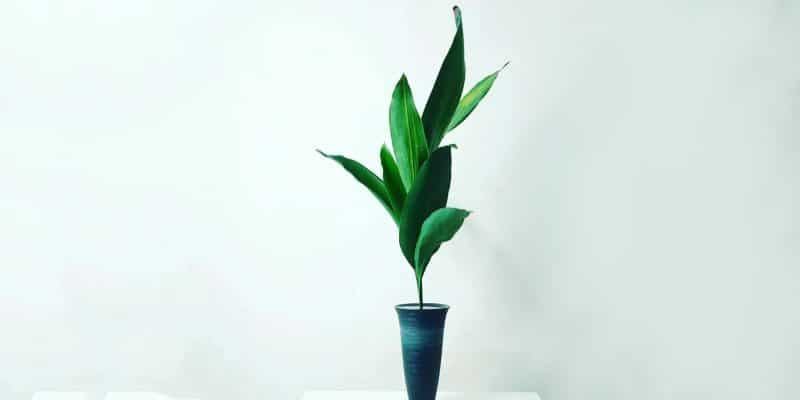Have we got the low-maintenance houseplant for you: the unassuming hero of the houseplant world, Aspidistra Elatior.
Affectionately known as the cast iron plant, Aspidistra Elatior is known for its ability to thrive even when neglected. If your home doesn’t have bright light or you get busy and forget about your plants, the cast iron plant is the houseplant for you.
We’ll reveal all the secrets to ideal Aspidistra Elatior care, including ideal environmental conditions, eye-catching cultivars, and the best way to propagate.
Table of Contents
Aspidistra Elatior Plant Care Guide
History, Habitat, and Characteristics
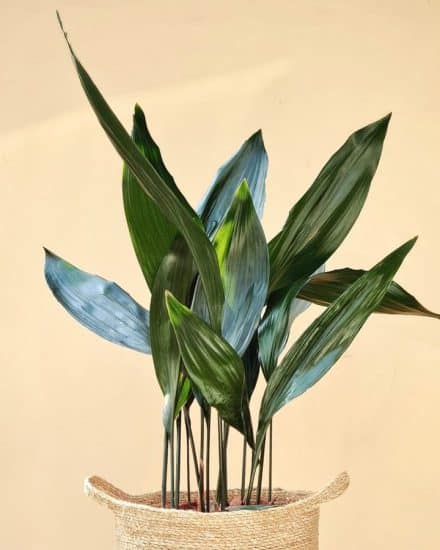
You might be wondering how Aspidistra Elatior became known as “cast iron.” Well, this plant’s natural environment is the shady forest floors of Japan. It’s famous for surviving the most challenging indoor and outdoor environments. It’s a popular indoor houseplant, but will grow in a shady outdoor garden in zones 8 and above.
The evergreen cast-iron plant is a member of the Asparagaceae family (like the Asparagus Fern), which formerly belonged to the lily family but is now its own classification. It features wide, long green leaves that grow in a bushy style. Its large leaves are so attractive that they’re used in the Japanese floral-design practice of ikebana.
So, what makes Aspidistra Elatior such a fantastic indoor companion? Well, it’s low-maintenance and can handle a wide range of conditions. It prefers low light and higher humidity, but can tolerate drought and heavy shade. When it’s happy, you’ll see its deep-green leaves take on a lighter hue and grow larger.
Although it rarely blooms inside, if grown outside, it develops creamy purple flowers in spring.
Fun fact: The Victorian author E.M. Delafield is credited with popularizing the nickname “cast-iron plant” in her 1918 novel The War Workers. She described it as “one of the most stolid and bourgeois of plants” — pretty fitting, don’t you think?
Cast-Iron Plant Cultivars
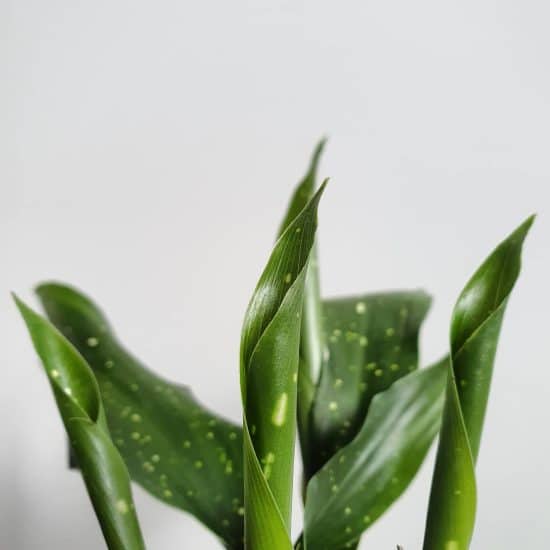
The are two beautiful spotted cultivars called Aspidistra ‘Milky Way,’ and ‘Hoshi-zora.’ Aspidistra ‘Milky Way’ is speckled with vibrant white dots. There’s also a variety called ‘Hoshi-zora,’ which translates to “starry sky” in Japanese, that has large speckled leaves as well, but only faintly in comparison.
Aspidistra ‘Lennon’s Song’ has dark green leaves with a long, thin yellow-gold stripe in the center that almost looks like a flame.
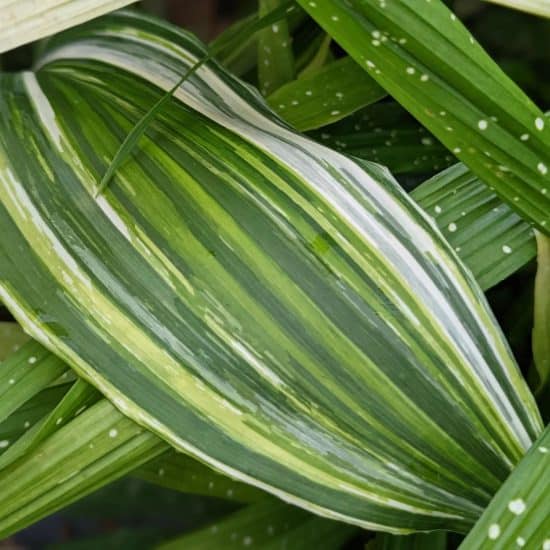
Last but not least, Aspidistra ‘Variegata’ has long white stripes running up and down its length, and has won the Royal Horticultural Society’s Award of Garden Merit.
Light
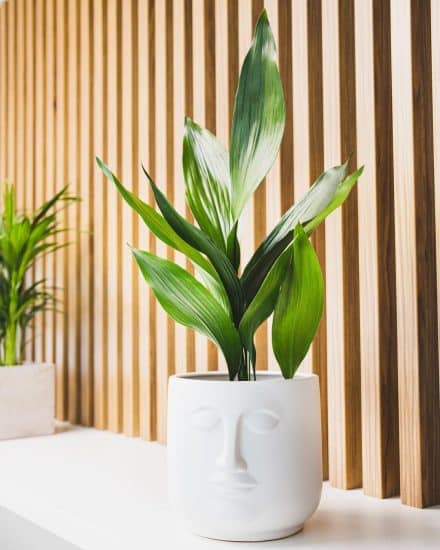
Perfect for beginner plant parents, cast-iron plants can handle low light areas and even shade, making them a great addition to your indoor garden. In fact, the cast-iron plant does so well in shady lighting that it’s also known as the “bar-room plant” or “barroom plant.”
Maybe the ultimate indoor plant?
Give your cast-iron plant indirect light, but remember, it can also do well in shaded areas, like those back corners, or near an east- or north-facing window. Keeping an eye on the leaves will tell you if you’re getting the lighting just right.
Remember, cast-iron plant is a low-light plant, so avoid exposing it to direct sunlight. Too much direct sun will cause leaf burn and crispy, brown leaf tips. If your plant’s leaves start to shrivel and turn brown, it’s getting too much sun.
On the other hand, when the lighting is too low, its dark-green leaves might become smaller and deformed, maybe even curling up and looking a bit darker in color. And while the cast-iron plant is a natural slow grower, insufficient light will result in unusually stunted growth.
Our lighting tips:
- Strive for indirect light or even light shade.
- Steer clear of intense direct sunlight to avoid leaf burn and brown tips.
- Small or deformed leaves may indicate your plant needs more light.
Water
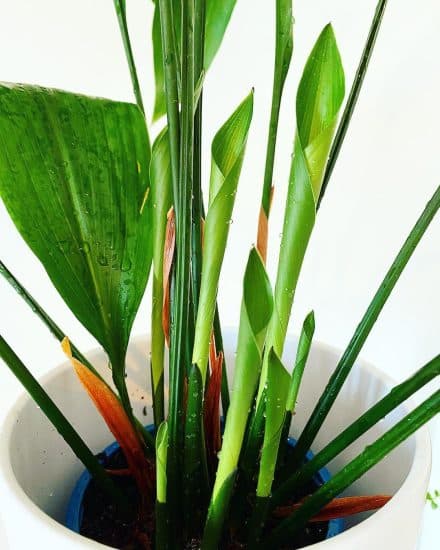
Cast iron plants are drought tolerant and can handle a dry spell, so they prefer to dry out completely between waterings. Overwatering can lead to disease problems, so it’s essential to hold off on watering until the top half of the soil is completely dry.
When it’s time to water, make sure you’re soaking the entire plant. If possible, use filtered water — cast-iron plants can be sensitive to the fluoride, chlorine, and minerals found in tap water.
To avoid overwatering, make sure your pot has drainage holes in the bottom. That way, excess water won’t drown the root system.
If your cast-iron plant is not getting enough water, you might see brown leaf tips or wilted, yellowing leaves that start to curl up. If you notice these signs in your plant, remove any damaged leaves and increase your watering by monitoring the soil and watering when it’s dry.
If your plant is getting too much water, you’ll notice yellowing leaves all over, mushy stems at the soil level, and wet soil that just won’t dry. Small brown and black spots on the leaves are also signs of overwatering.
In this case, cut back on your watering frequency and let the soil dry out completely before watering again.
Temperature and Humidity
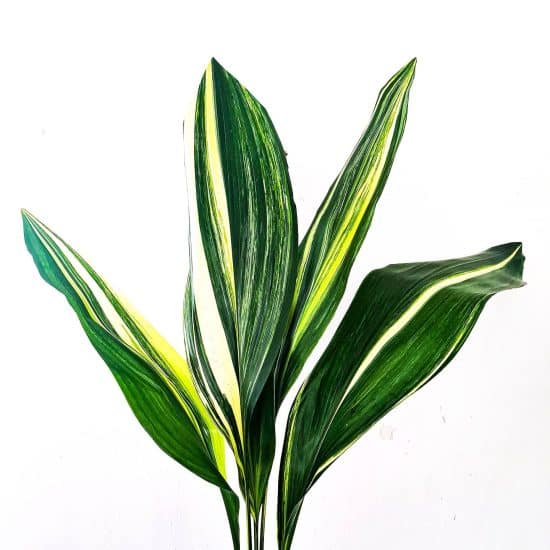
Cast-iron plants are hardy plants and can tolerate a wide range of temperatures, but ideal temperatures fall between 60°F and 80°F (16-26°C). However, they can also survive in cold temperatures as low as 45°F (7°C) or as high as 85°F (30°C).
If the temperature is too high, your cast-iron plant might exhibit wilting or drooping leaves. If this happens, try moving your plant to a cooler location, away from direct sunlight or heat sources, such as radiators.
One of the most appealing characteristics of cast-iron plants is their flexibility when it comes to humidity levels, making them more tolerant of drafts than many other houseplants. Average home humidity levels around 40%-60% should be sufficient, but if you notice curling or browning of cast-iron plant leaves, raising the humidity couldn’t hurt.
You can place your cast-iron plant near a humidifier or on a tray filled with pebbles and water to increase humidity levels. Alternatively, consider grouping your cast-iron plant with other plants so they can share moisture through a process called transpiration.
Temperature and humidity care tips:
- Keep your cast-iron plant within the ideal temperature range of 60°-80°F (16°-26°C) and away from extreme temperature drops or highs.
- Average indoor humidity should be sufficient, but try to maintain levels around 40%-60% for optimal growth.
- Increase indoor humidity by using a humidifier, placing your plant on a tray of pebbles and water, or grouping it with other plants.
- Monitor your cast-iron plant for signs of temperature or humidity issues, such as drooping leaves or brown leaf tips, and take action accordingly.
Soil and Planting
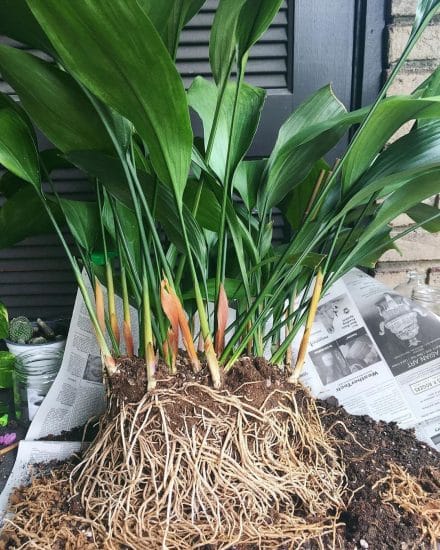
Growing cast-iron plants doesn’t necessarily require any specific type of soil, but well-draining and somewhat moisture-retentive soil is best.
A mix of two-thirds standard potting mix and one-third perlite, or 70% potting mix with 30% perlite, works well. Add worm castings, compost, or coco coir to provide essential nutrients and promote healthy growth.
Poor soil can lead to various issues in cast-iron plants. If your plant is experiencing slow growth, yellowing leaves, or wilted leaves despite sufficient water and light, it could be a sign of poor soil quality.
Improper drainage can lead to weakened overall health of your plant. To resolve this, consider replacing the potting mix with the recommended blend above and make sure it drains well.
Since cast-iron plants are slow growing, they don’t need frequent repotting. It’s only necessary to repot every two to five years.
When repotting, choose a container slightly larger than your plant’s current pot, ensuring it has proper drainage holes. Handle the root ball gently and use the recommended soil mix for best results.
Fertilizer
Fertilize cast-iron plants during the growing season in spring and summer. You can use a well-balanced fertilizer for houseplants once a month or every fourth time you water. Reduce or eliminate fertilizing during the semi-dormant winter months.
Over-fertilizing your cast-iron plant can result in brown tips and edges on the leaves, a sign of nutrient burn. Additionally, white crusts on the soil surface are a clear indication of fertilizer salt buildup.
To resolve these issues, reduce the frequency of fertilization and flush the soil by watering thoroughly until water drains out of the bottom of the pot.
Propagation
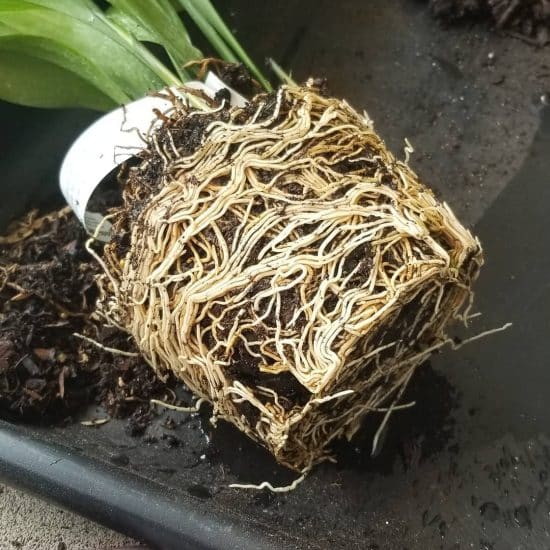
The easiest way to propagate your cast-iron plant and make new plants to share is through root division. Feed two birds with one scone by propagating when you repot. That way, you won’t have to disturb the root system twice.
Propagate cast-iron plant via root division:
- Gather your gear: First things first, you’ll need a clean, sterile knife, a new pot filled with fresh soil, and a strong, healthy mother plant.
- Timing is everything: The ideal time to divide roots (and repot) for healthy growth is early spring, when the growing season is just starting.
- Free the plant: Carefully take the mother plant out of the old pot and give the roots a little shake to remove excess soil. This will make it super easy to spot the rhizome and work with the roots.
- Divide and conquer: With your clean, sterile knife in hand, cut off a portion of the rhizome, making sure it has at least a few leaves attached. Make sure there are already some healthy roots attached — this boosts your chance of successful propagation.
- Pot the new plant: Pop the rhizome cutting into the fresh soil, covering the roots well. Keep the leaves above the soil surface — you don’t want to bury them.
- Give it a good life: Place your new little plant buddy in a warm spot with moist air, indirect light (like a north-facing window) and consistent moisture. As with the mother plant, avoid direct sun.
- Watch it grow: With a little love and attention, your new cast-iron plant will start showing new growth in just a few weeks. Once it’s all settled, you can slowly adjust it to the same care routine as the mother plant.
Common Issues
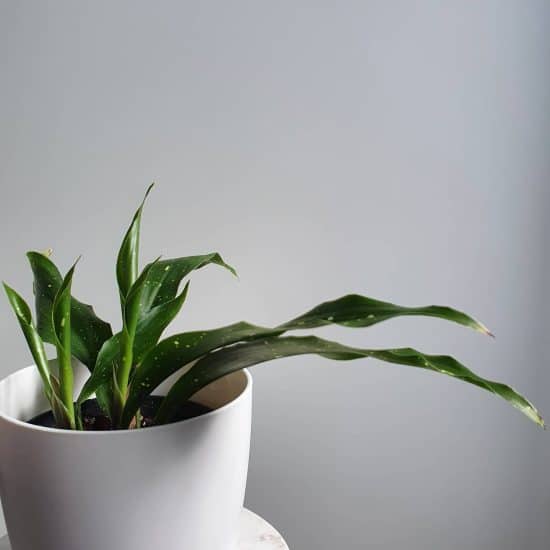
Aspidistra Elatior is a hardy plant, but it can still have issues with slow growth or droopy leaves.
Slow Growth
Growing cast-iron plants is generally a slow process, but if you’re finding that yours isn’t sprouting new leaves for quite some time, there could be a few reasons.
First, check for dust on your cast-iron plant’s large, dark-green leaves. A layer of dust can interfere with photosynthesis and contribute to slow growth. So, make sure you give the leaves a gentle wipe with a damp cloth or a soft brush every now and then to keep them dust-free.
Another reason for slow growth could be too much shade. Sometimes with plants that do well in lower light, people will go too far with the shade and not give them enough sunlight. No plant can live in total darkness, even cast-iron plants, so make sure yours is in a room with a window.
Dead or Dying Leaves
Now, let’s address dead or dying leaves. It’s essential to prune them right at the base, so they don’t decay and affect the plant’s growth. To help your cast-iron plant thrive, check if it’s getting the right light (indirect light, no direct sun) and evaluate your watering routine.
Make sure you water it just when the soil starts to feel dry, soaking it completely. And here’s a little insider tip: Use filtered water instead of tap water to avoid brown tips on the leaves!
Drooping Leaves
Are the leaves drooping on your cast-iron plant? Drooping leaves might be a sign of over- or underwatering. To figure out what’s going on, check the condition — is the soil wet or soggy? If the answer is yes, overwatering could be the culprit.
To help your plant bounce back, make sure it has proper drainage. Repotting your plant in a new pot with fresh soil and good drainage holes might be necessary if you suspect it’s been a victim of overwatering. Remember to let it dry out — this will help you avoid overwatering in the future.
On the other hand, soil that feels rock hard or is separating from the side of the pot means it’s too dry. Underwatering can also cause leaves to look deformed, curled, and discolored. If that’s the issue, water your cast-iron plant more frequently and thoroughly.
In some cases, too much shade and not enough indirect light can cause drooping leaves. Try moving your plant to a brighter spot with some nice indirect light.
Pests and Diseases
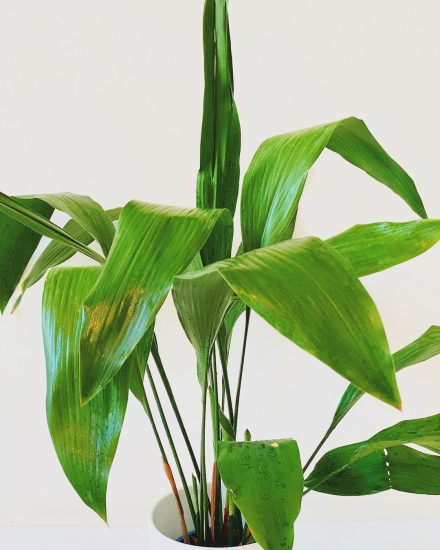
Spider Mites
Spider mites are tiny little pests that might take up residence on your cast-iron plant leaves. If you see tiny white or red specks and fine webbing on the leaves of new or mature plants, that’s them!
Here’s how to kick them out:
- With a damp cloth or paper towel, gently wipe off the affected leaves.
- Whip up a simple solution of water and a few drops of mild dish soap, and give those leaves a good spray.
- Keep at it every few days until you’ve shown those mites who’s boss!
And for the future? Give your plant’s leaves a regular cleaning and keep humidity levels up. A little misting with water now and then should do the trick. But don’t overdo it. Too much moisture on plant leaves can cause other problems, like fungus.
Root Rot
Rot can affect even the toughest of indoor plants, including cast-iron plants. Usually, this nasty issue rears its ugly head when the plant’s soil stays wet for too long. Untreated, it can permanently damage your plant.
So, how do you know if you’ve got root rot? Look out for these telltale signs:
- Roots that are mushy, slimy, and discolored
- Yellowing or wilting leaves
- A funky smell from the pot or soil (trust me, you’ll know it when you smell it)
Here’s how to save your plant:
- Gently remove your plant from its pot and give those roots a good once-over.
- With clean, sterilized scissors, snip away any affected roots.
- Repot your plant with fresh, well-draining soil. Add some perlite, pumice, or LECA for aeration and drainage.
- Go easy on the water until the problem’s resolved.
To keep root rot from happening again, let your cast-iron plant’s soil dry out between waterings, and make sure your pot has proper drainage holes. Never let your plant sit in standing water.
Conclusion
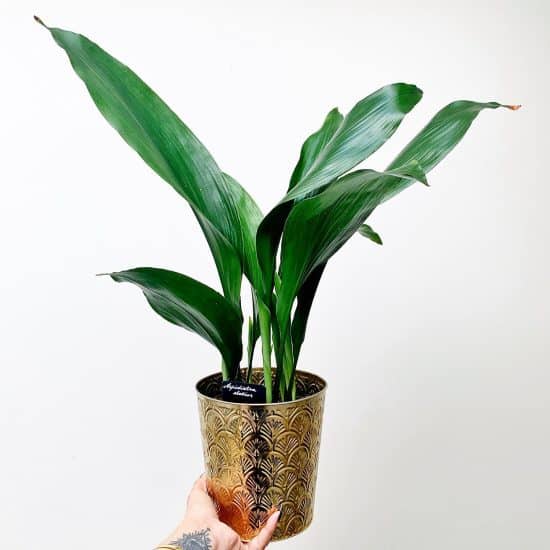
That’s a wrap for our cast-iron plant care guide!
Aspidistra Elatior is perfect for anyone looking to add a touch of green to their home without extra fuss.
Remember these key points for a thriving cast-iron plant:
- Provide indirect light and avoid harsh direct sunlight.
- Plant in well-draining soil and a container with proper drainage holes.
- Water only when the top half of the soil is dry, and use filtered water if you have it.
- Maintain an ideal temperature range of 60° to 80° F (16° to 26° C) and a humidity level around 40%-60%.
We hope this cast-iron plant care guide has provided you with all the knowledge you need to care for your plant with confidence. Remember, this plant will tolerate a variety of conditions, so don’t be afraid to give it a try.
If you found this article helpful, share it with a friend or on social media, and please reach out to us with any questions or concerns.
Happy planting, and take care!
FAQ
Is Aspidistra Elatior an indoor plant?
Oh, absolutely! In fact, it’s made a name for itself as one of the most low-maintenance and resilient houseplants you can find. While it prefers low light and higher humidity when grown indoors, it can adapt to a wide range of indoor conditions.
Will cast-iron plants survive winter?
Although they thrive best in temperatures between 60°F to 80°F (16° to 26°C), these hardy plants can tolerate temperatures as low as 45°F (7°C). Keep in mind, though, if you’re expecting a frosty winter, it’s wise to move your cast-iron plant to a more protected indoor spot away from chilly drafts or cold windows.
Why is it called cast-iron plant?
The nickname “cast-iron plant” has a pretty fascinating history. This tough-as-nails plant earned this name because it can survive even the most challenging indoor environments. Author E.M. Delafield is credited with popularizing the name in a novel.

